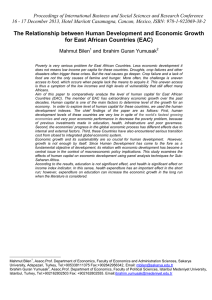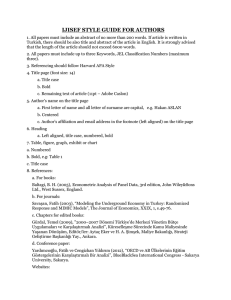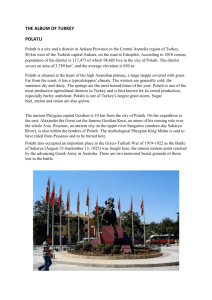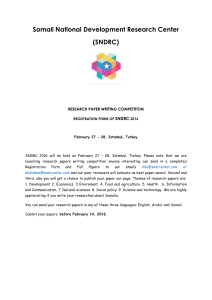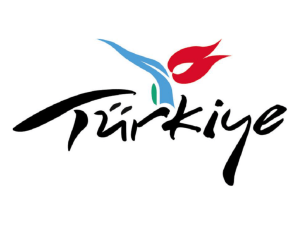2 GEOGRAPHY, GEOLOGY AND HYDROGEOLOGY OF MARMARA REGION 2.1 Geography
advertisement
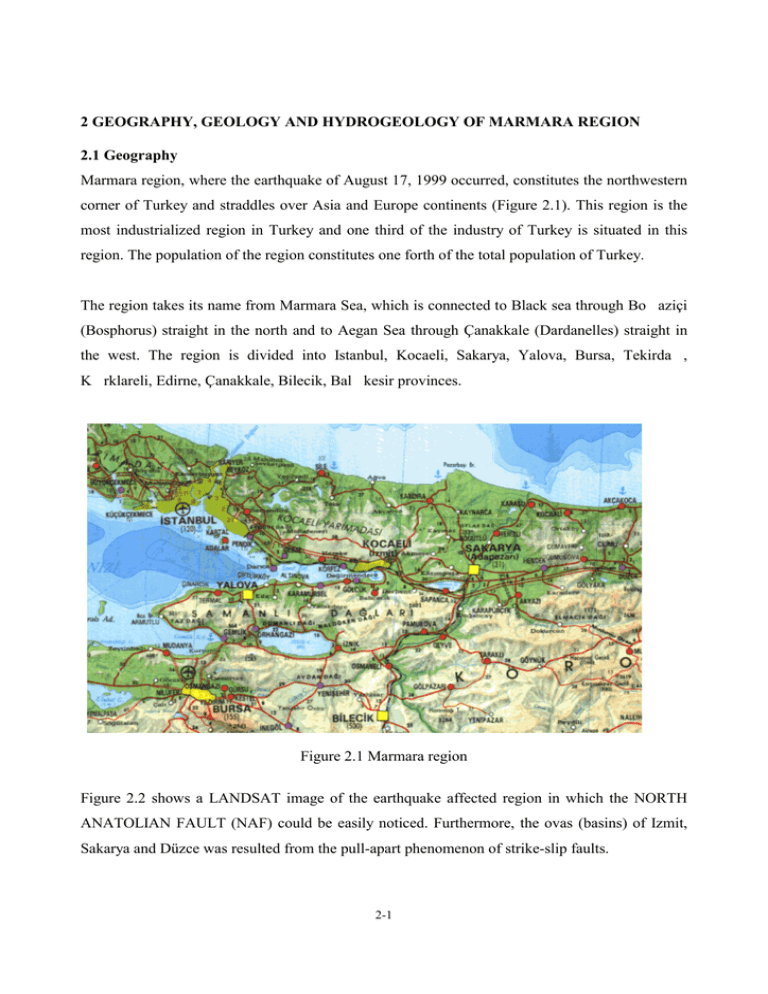
2 GEOGRAPHY, GEOLOGY AND HYDROGEOLOGY OF MARMARA REGION 2.1 Geography Marmara region, where the earthquake of August 17, 1999 occurred, constitutes the northwestern corner of Turkey and straddles over Asia and Europe continents (Figure 2.1). This region is the most industrialized region in Turkey and one third of the industry of Turkey is situated in this region. The population of the region constitutes one forth of the total population of Turkey. The region takes its name from Marmara Sea, which is connected to Black sea through Bo aziçi (Bosphorus) straight in the north and to Aegan Sea through Çanakkale (Dardanelles) straight in the west. The region is divided into Istanbul, Kocaeli, Sakarya, Yalova, Bursa, Tekirda , K rklareli, Edirne, Çanakkale, Bilecik, Bal kesir provinces. Figure 2.1 Marmara region Figure 2.2 shows a LANDSAT image of the earthquake affected region in which the NORTH ANATOLIAN FAULT (NAF) could be easily noticed. Furthermore, the ovas (basins) of Izmit, Sakarya and Düzce was resulted from the pull-apart phenomenon of strike-slip faults. 2-1 Figure 2.2 LANDSAT view of the earthquake affected region 2.2 Geology According to Ketin (1973) and Okay (1986), Marmara region geologically divided into three parts, namely, Istranca masif, Istanbul zone and Sakarya zone as illustrated in Figure 2.3(a). Between Istanbul zone and Sakarya zone, the intra-pontid suture exists which roughly follows the northern strand of the North Anatolian Fault. The southern part of the Istranca massif is called Trakya (Thrace) basin. It is overlaid by Cenosoic sedimentary rocks and quaternary alluvial deposits (Yüzer, 1997). Sedimentary rocks consist of sandstone, sandy-clay and fossiliferous limestone. The thickness of sediments in the Trakya basin reaches up to 6000m. The Istranca Massif consists of sandstone, quartzite, shale, limestone and Late Permian granitoid deformed and metamorphosed during the Late Jurassic. Its contact with the Istanbul Zone further east is covered by the Eocene sediments. The metamorphic rocks of the Istranca Massif are composed of metagranite, micaschist, marble, calcschist, quartzite and phyllite. 2-2 The Istanbul Zone is characterized by a well developed, unmetamorphosed and little deformed continuous Paleozoic sedimentary succession extending from Ordovician to the Carboniferous overlain with a major unconformity by latest Permian to lowermost Triassic continental red beds. The Istanbul Zone is very distinctive from the neighboring tectonic units in its stratigraphy, absence of metamorphism and lack of major deformation. The Intra-Pontide Suture of Late Triassic-Early Jurassic age separates Istanbul and Sakarya Zones. In marked contrast to the Istanbul Zone, the Sakarya Zone does not have a Paleozoic basement. The Sakarya Zone is characterized by a variably metamorphosed and strongly deformed Triassic basement called the Karakaya Complex overlain with a major unconformity by Liassic conglomerates and sandstones which passes up to Middle Jurassic-Lower Cretaceous limestones and Upper Cretaceous flysch. Karakaya Complex of Triassic age made up of strongly deformed and metamorphosed basic volcanic rocks, limestones and greywackes with limestone olistoliths forms the basement to the undeformed post-Triassic sediments of the Sakarya Zone. The Karakaya Complex probably represents a Triassic magmatic arc/forearc/trench complex and may be part of a Cimmerian "Continent". The Sakarya Zone is separated from the AnatolideTauride units by the Izmir-Ankara-Erzincan Suture. The internal structure of the Karakaya Complex is poorly known (Figure 2.3(b)). However, it is apparently made up of several tectonic units including a thick volcanic section with abundant basic pyroclastics and tuffs intercalated with carbonates, and a greywacke section with Permian and Carboniferous limestone olistoliths. The metamorphism where it occurs is generally in highpressure greenschist facise, and sodic amphibole occurs frequently in basic volcanic rocks. The rocks are generally steeply dipping and are strongly deformed with isoclinal folds with subvertical axial planes. The deformation is locally semi-brittle giving a broken formation character to the Karakaya Complex. The Karakaya Complex is also intruded by several pre-Liassic granitoids. The gulf is an east-west trending active graben which is dynamically affected by the interaction of the North Anatolian Fault Zone and the Marmara graben systems (Seymen 1995). It is bounded by two horsts: the Kocaeli Peninsula to the north and the Armutlu Peninsula to the south, 2-3 showing completely different geomorphological features, and by well defined fault scarps. The graben varying between 6 km and 10 km in width is comparatively large, long and narrow basin filled with young sediments of marine and continental facies. (a) (b) Figure 2.3 Geological units of the Marmara region modified from Ketin (1967) and Okay (1986). The Kocaeli and Armutlu peninsula stratigraphically, structurally, and geologically gave completely different geological features; so that the intra-Pontid suture between Istanbul and Sakarya zones defined within the western Pondites is passed along the long axis of the graben. Figure 2.4 shows a cross-section in the north-south direction. Figure 2.4 A geological N-S cross-section of Izmit Gulf (after Seymen 1995) Izmit Gulf is said that it was subjected to Flandrian transgression following its formation (Ho gören 1995). The deepest point of the gulf that has a length of 50 km with a varying width, 2-4 is at the off-shore of Ere li-Ula l with a depth of more than 200 m. Two types of coastal forms are observed, one as low beach and the other as high clif. The low beach type is the dominant one. There are several deltas at the mouths of the relatively big creeks. Hersek, Laledere and Dil Dere deltas are examples. Along the coast there are Late Pleistocene (tyrrhenian) age marine terraces and sediment depositions as in Yalova-Lale Dere, Hersek and Karamürsel. Figure 2.5 shows the quaternary alluvial deposits distributions in the vicinity of the earthquake epicenter. In addition to the quaternary deposits along the shores of Izmit Gulf, the vicinity of Sakarya river is covered by alluvial deposits. These deposits are generally consisted of loose sand and silt. Furthermore, these alluvial deposits are likely to cause ground liquefaction and prolong the duration of shaking during earthquakes. Figure 2.5 Ovas (basins) with Quaternary deposits in the earthquake affected region 2.3 Hydrogeology The rivers of Sakarya, Susurluk and Ergene are the main rivers of the Marmara region. The river associated with the region is Sakarya river which originates from Emir Mountains in Afyon Province. These rivers mainly flow in the direction of N-S while their branches flow mostly in the direction of E-W. Sapanca Lake is connected to Sakarya river through a natural branch. 2-5 Figure 2.6 shows monthly averages of precipitation, evaporation and temperature for at Kartal(Istanbul) Station (data from Yüzer 1997). The highest precipitation generally occurs during December and April while the highest evaporation occurs during in July. Nevertheless, water table is generally close to the ground surface in the cities and towns situated on low lands where damage was quite heavy. For example the ground water level is almost at the same level as 30 KARTAL (ISTANBUL) Precipation Evaporation Temperature 150 25 125 20 100 15 75 10 50 25 5 0 1 0 9 10 11 12 2 3 4 5 6 7 8 MEAN TEMPERATURE ( 0C) AVERAGE PRECIPITATION (mm) AVERAGE EVAPORATION (mm) 175 DEC. SEP. JULY MAY JAN MARCH the ground surface in Adapazar , Izmit, Sapanca, Gölcük and Yalova. MONTH Figure 2.6 Monthly averages of precipitation, evaporation and temperature References Ho gören, M.Y.. (1997). Geomorphology of basin of the Gulf of Izmit. Izmit Körfezinin Kuvaterner stifi, Gölcük, 343-348. Ketin, . (1973): Umumi Jeoloji (General Geology), Published by TÜ, 4th Ed. Okay, A.I. (1986): Tectonic units and sutures in the pontides, Northern Turkey. Tectonic evolution of the Tethyan Region, NATO ASI Series. Series C-Vol.259, 109-116. 2-6 Seymen, . (1997). Geology of the Gulf of zmit (NW Turkey). zmit Körfezinin Kuvaterner stifi, Gölcük, 259- 267. Yüzer, E. (1997): Hydrogeology of Northwestern Turkey. Active Tectonics of the Nortwestern Anatolia – The Marmara Poly-Project, 125-137. 2-7
